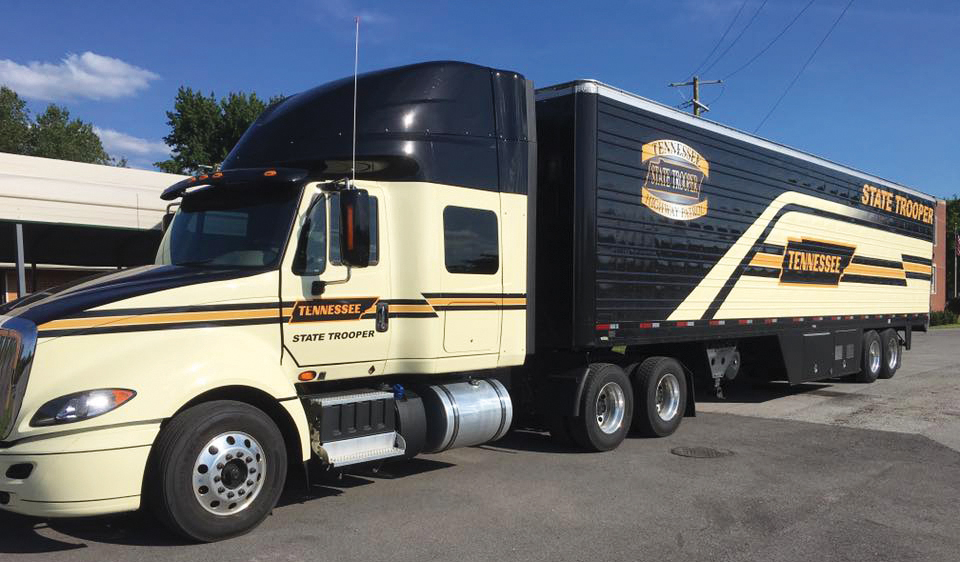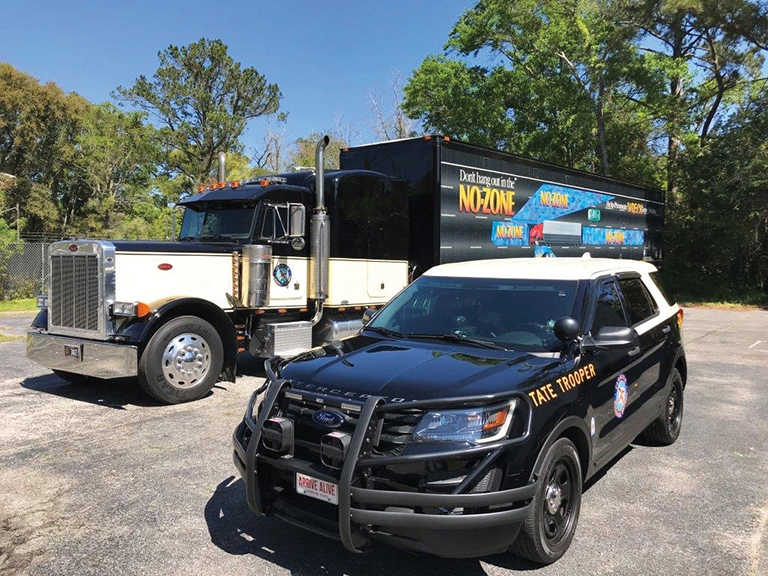Semitrucks may be primarily used to haul goods from one place to another, but what if big rigs could become more like traveling superheroes?
That’s something the highway patrol agencies in Florida and Tennessee are proving to be possible with their use of tractor-trailers in traffic law enforcement and education initiatives.
The highway patrol rigs don’t “transform” like Optimus Prime, but they do play a vital role helping keep highways safe. Both Florida and Tennessee are using commercial motor vehicles (CMVs) to educate the public and, at the same time, help prevent traffic crimes.
Both departments obtained semitrucks through criminal or intervention searches and seizures. After safety inspections, the patrols decided to put them to use. In total, the Florida Highway Patrol has six semitrucks that are used for traffic stops along the highway.
“We have used (them) for outreach and educational purposes for commercial motor vehicles, as well as the education and enforcement of traffic laws in the state,” said Dylan Bryan, master sergeant for the Florida Highway Patrol.
These vehicles are often showcased during safety presentations at high schools or trucking companies, or at commercial vehicle “rodeos.” The rigs are also used to educate the public about the blind spots of semitrucks.
“We set up vehicles within the blind spot of a tractor-trailer and what the driver can and can’t see, and use that as a demonstration purpose for the motor-vehicle public to see exactly what it’s like being in that cab — and hopefully educate those drivers when they operate their own vehicles around commercial motor vehicles,” Bryan said.
The Florida Highway Patrol works with the National Highway Transportation Safety Administration (NHTSA), the Florida Department of Transportation (FDOT) and the Florida Truckers Association.
Other than education, the patrol occasionally uses the semitrucks to issue traffic-violation citations through its program Operation Safe DRIVE: Distracted Reckless Impaired Visibility Enforcement.
To do this, the semitruck, along with a conventional patrol car, is stationed on the side of the highway to observe any reckless or dangerous driving. Bryan said using a semitruck gives two advantages to the highway patrol — it allows patrol officers to be eye level with drivers of other semitrucks, and provides a wider view for observing the movements of smaller vehicles.
The vantage point from a semitruck allows a wider view to observe motor vehicle drivers using cell phones, speeding or following too closely to another vehicle.
The Florida Highway Patrol deploys a semitruck two or three times a month to monitor traffic violations.
“When we start deploying these vehicles, it’s not like we’re hiding,” Bryan said. “We’ll use a marked vehicle, pick a stretch of road that’s 8 to 10 miles long, and we’ll do several loops around it. We’ll see the violations that you normally see drastically decrease once we’ve made a few stops here and there. You know the community is talking, and it’s nice to see that. The end result is that people are driving safer, and that’s what we want.”
The Tennessee Highway Patrol also occasionally uses semitrucks to spot violations.

During a recent 24-hour event stretching from the Kentucky state line to the Tennessee and Georgia state lines, there were zero fatalities on Interstate 24 while the Tennessee Highway Patrol patrolled using its semitruck, according to Lt. Bill Miller, public information officer for Tennessee Highway Patrol.
Much like the Florida initiatives, the main usage of Tennessee’s semitruck is for education and training across the state. The truck has been flipped into a “Teens and Truck” driving simulator that assists teenagers in understanding how to drive around semitrucks.
“It has six driving simulators and it kind of looks like a video arcade, so it immediately grabs their attention, and they want to participate,” said Lt. Allen England of the Tennessee Highway Patrol.
The driving simulators have 10 different simulations to show students driving scenarios such as a CMV’s blind spots, driving around a CMV or driving the CMV. To combat cellphone usage on the road, the driving simulator also tests students with popup notifications and grades their answers.
“The equipment is completely equipped with vibration in the chair, so the teen feels if they did something wrong,” Miller said. “If they sideswiped the car or struck a deer that was running across the roadway, or had a crash, they (can) feel the vibration through the chair in their body.”
Before the COVID-19 pandemic, Tennessee’s semitruck was taken out three to four times a month, traveling around a school system within 95 counties, Miller noted.
“It’s one of the most popular and highly requested services that the Tennessee Highway Patrol has,” he added.
The usage has inspired the Georgia Highway Patrol to research implementing a similar educational semitruck, according to Miller.
Although both Florida and Tennessee highway patrols have implemented CMV usage, officers don’t plan to completely ditch their Dodge Chargers for semitrucks anytime soon.
“Realistically, it’s not practical to use it as a solo vehicle to try to enforce traffic laws, simply because it’s so large,” Miller said. “Traffic is more and more congested each day. With it being a semi, if you’re trying to make a traffic stop with it, you do have the increased chance of someone trying to flee or elude law enforcement.”
Using semitrucks can also be costly. Bryan said the operating costs and maintenance may dissuade police departments from implementing semi-trucks.
“On the flip side, I do think it’s beneficial,” Bryan said. “I think it’s a very effective program, and I’m thankful the Florida Highway Patrol is continuing that program. It’s very unique.”
Hannah Butler is a lover of interesting people, places, photos and the written word. Butler is a former community newspaper reporter and editor for Arkansas Tech University’s student newspaper. Butler is currently finishing up her undergraduate print journalism degree and hopes to pursue higher education. Her work has been featured in at least nine different publications.








